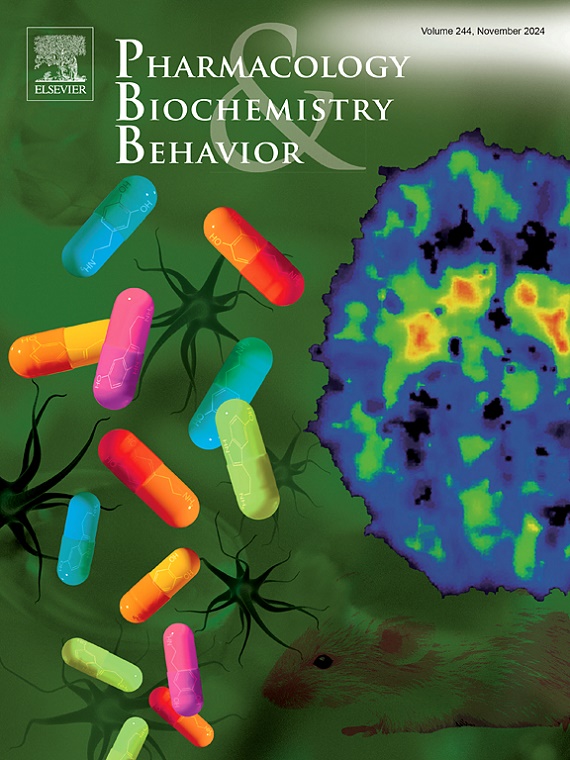Pre-exposure to eutylone attenuates its own aversive effects but has no impact on cocaine or MDMA: A possible role of eutylone's hybrid pharmacology
IF 3.3
3区 心理学
Q1 BEHAVIORAL SCIENCES
引用次数: 0
Abstract
Previous research has reported that pre-exposure to a variety of drugs of abuse can impact (reduce) the aversive effects of themselves and other abused compounds, often as a function of their shared pharmacological activity. In this context, the present series of studies investigated the effects of history with the synthetic cathinone eutylone on the aversive effects of cocaine, MDMA, and itself in adult, male Sprague-Dawley rats. Given eutylone's structural similarities with its parent compound methylone, it was predicted that its ability to attenuate cocaine- and MDMA-induced taste avoidance would parallel the effects of methylone pre-exposure in this design (cocaine > MDMA). In Experiment 1, male Sprague-Dawley rats were exposed to eutylone (20 mg/kg, IP) or equivolume saline every other day for five exposures followed by taste avoidance conditioning with 20 mg/kg cocaine (SC) or 1.8 mg/kg MDMA (SC). Both cocaine and MDMA induced significant taste avoidance that developed over repeated conditioning trials. Cocaine and MDMA-induced avoidance were unaffected by eutylone history. To assess the general ability of eutylone pre-exposure to attenuate taste avoidance conditioning in the pre-exposure design, in Experiment 2, an additional set of male Sprague-Dawley rats was injected with 20 mg/kg eutylone (IP) prior to taste avoidance conditioning with eutylone (20 mg/kg (IP). Under these conditions, eutylone-induced avoidance was attenuated by eutylone pre-exposure. Given that eutylone history attenuated eutylone-induced avoidance argues that the failure to affect cocaine or MDMA was not a function of eutylone in this preparation. The inability of eutylone to attenuate the aversive effects of cocaine and MDMA despite sharing pharmacological activity suggests that eutylone's hybrid pharmacology may create a unique interoceptive effect different than that produced by either drug.
预暴露于真tylone减弱其自身的不良影响,但对可卡因或MDMA没有影响:真tylone的混合药理学的可能作用
以往的研究表明,预先接触各种滥用药物会影响(降低)其本身和其他滥用化合物的厌恶效应,这通常是由于它们具有共同的药理活性。在这种情况下,本系列研究调查了在成年雄性 Sprague-Dawley 大鼠体内使用合成卡西酮优泰酮对可卡因、摇头丸和自身的厌恶效应的影响。鉴于丁酮与其母体化合物甲酮在结构上的相似性,我们预测丁酮减弱可卡因和亚甲二氧基甲基苯丙胺诱发的味觉回避的能力将与本设计(可卡因> 亚甲二氧基甲基苯丙胺)中预先暴露甲酮的效果相似。在实验 1 中,雄性 Sprague-Dawley 大鼠每隔一天暴露于优甲龙(20 毫克/千克,IP)或等体积生理盐水,共暴露 5 次,然后用 20 毫克/千克可卡因(SC)或 1.8 毫克/千克摇头丸(SC)进行味觉回避调节。可卡因和亚甲二氧基甲基苯丙胺都会诱发明显的味觉回避,这种回避会在重复的条件反射试验中逐渐形成。可卡因和亚甲二氧基甲基苯丙胺诱导的回避不受优甲乐的影响。在实验 2 中,为了评估在预暴露设计中丁酮预暴露减弱味觉回避条件反射的一般能力,在用丁酮(20 毫克/千克(IP))进行味觉回避条件反射之前,又给一组雄性 Sprague-Dawley 大鼠注射了 20 毫克/千克丁酮(IP)。在这些条件下,丁酮诱导的回避会因预先暴露于丁酮而减弱。鉴于戊乙酮会减弱戊乙酮诱导的回避,这就表明在这种制剂中,戊乙酮对可卡因或亚甲二氧基甲基苯丙胺没有影响并不是它的作用。尽管具有相同的药理活性,但丁乙酮无法减弱可卡因和摇头丸的厌恶效应,这表明丁乙酮的混合药理作用可能会产生不同于这两种药物的独特感知间效应。
本文章由计算机程序翻译,如有差异,请以英文原文为准。
求助全文
约1分钟内获得全文
求助全文
来源期刊
CiteScore
6.40
自引率
2.80%
发文量
122
审稿时长
38 days
期刊介绍:
Pharmacology Biochemistry & Behavior publishes original reports in the areas of pharmacology and biochemistry in which the primary emphasis and theoretical context are behavioral. Contributions may involve clinical, preclinical, or basic research. Purely biochemical or toxicology studies will not be published. Papers describing the behavioral effects of novel drugs in models of psychiatric, neurological and cognitive disorders, and central pain must include a positive control unless the paper is on a disease where such a drug is not available yet. Papers focusing on physiological processes (e.g., peripheral pain mechanisms, body temperature regulation, seizure activity) are not accepted as we would like to retain the focus of Pharmacology Biochemistry & Behavior on behavior and its interaction with the biochemistry and neurochemistry of the central nervous system. Papers describing the effects of plant materials are generally not considered, unless the active ingredients are studied, the extraction method is well described, the doses tested are known, and clear and definite experimental evidence on the mechanism of action of the active ingredients is provided.

 求助内容:
求助内容: 应助结果提醒方式:
应助结果提醒方式:


